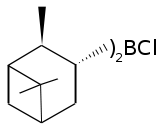- Diisopinocampheylborane
-
Diisopinocampheylborane  Bis{(1S,2S,3S,5R)-2,6,6-trimethylbicyclo[3.1.1]heptan-3-yl} boraneOther names(+)-Di-3-pinanylborane; Diisopinocampheylborane; Ipc2BH
Bis{(1S,2S,3S,5R)-2,6,6-trimethylbicyclo[3.1.1]heptan-3-yl} boraneOther names(+)-Di-3-pinanylborane; Diisopinocampheylborane; Ipc2BHIdentifiers Abbreviations Ipc2BH CAS number 21947-87-5 ChemSpider 10618744 Jmol-3D images Image 1 - [H]B(C1CC2CC(C1(C))C2(C)(C))C3CC4CC(C3(C))C4(C)(C)
- InChI=1S/C20H35B/c1-11-15-7-13(19(15,3)4)9-17(11)21-18-10-14-8-16(12(18)2)20(14,5)6/h11-18,21H,7-10H2,1-6H3
Key: KBGJOMVTAXYPAG-UHFFFAOYSA-N
InChI=1/C20H35B/c1-11-15-7-13(19(15,3)4)9-17(11)21-18-10-14-8-16(12(18)2)20(14,5)6/h11-18,21H,7-10H2,1-6H3
Key: KBGJOMVTAXYPAG-UHFFFAOYAB
Properties Molecular formula C20H35B Molar mass 286.3 g mol−1 Appearance Colorless solid Except where noted otherwise, data are given for materials in their standard state (at 25 °C, 100 kPa) Infobox references Diisopinocampheylborane is an organoborane that is useful for asymmetric synthesis. This colourless solid is the precursor to a range or related reagents. The compound was reported in 1961 by Zweifel and Brown in a pioneering demonstration of asymmetric synthesis using boranes. The reagent is mainly used for the synthesis of chiral secondary alcohols.
Contents
Preparation
Diisopinocampheylborane was originally prepared by hydroboration of excess α-pinene with borane,[1] but it is now more commonly generated from borane-methyl sulfide (BMS).[2]
Structure, general properties, reactions
The compound can be isolated as a solid, but it is quite sensitive to water and air and is thus often generated in situ and used as a solution. Oxidation of diisopinocampheylborane yields isopincampheol.[3] It adds to alkenes and alkynes to form the corresponding alkyl- and vinyldiisopinocampheylboranes, where G is CHR and R is Ipc and H:
Diisopinocampheylborane is monomeric, in contrast to diborane and many of its less bulky derivatives that contain B-H bonds. Because of the large size of the α-pinenyl groups, diisopinocampheylborane does not hydroborate hindered alkenes but when it does add, it does so with high enantioselectivity, even for small L's. 2-Butene, 2-pentene, 3-hexene are converted with Diisopinocampheylborane to the respective chiral alcohols in high ee's. Norbornene under the same conditions gave a 83% ee, due to the additional steric effects involved. Hetrocycles (dihydrofuran, dihydrothiophene, dihydropyrrole, tetrahydropyran) give the alcohol in ≥99% ee; the high ee's reflect their contrained conformations.[4] In a highly stereoselective reaction, allyldiisopinocampheylboranes converts aldehydes to the homologated alcohols, rapidly even at -100 °C.[5]
The alkyldiisopinocampheylboranes, which result from the addition to alkenes, usefully react with a range of different reagents. Hydroxylamine-O-sulfonic acid provides 3-pinanamine.[6] Hydroboration of 2-butene with diisopinocampheylborane followed by oxidation gives R-(-)-2-butanol in 87% ee.[7][7]
Also useful, reaction with an aldehyde gives a chiral boronic ester,[7] which can be further used is a number of reactions e.g. Suzuki reaction.
Related campheylboranes
Treatment of diisopinocampheylborane with TMEDA give the crystalline adduct of monoisopinocampheylborane. This adduct reacts with boron trifluoride to liberate the monoisopinocampheylborane (IpcBH2) in 100% ee.[8] Monoisopinocampheylborane reacts with a variety of alkenes.[7]. Two other reagents have been developed for the hydroboration of ketones:
In the above mechanism where G=O and R is Ipc and Cl or 9-Borabicyclononane. Diisopinocampheylchloroborane (Ipc2BCl) is produced by treating diisopinocampheylborane with hydrogen chloride. The chloride is reported to be more stable that the trialkyl boranes,[7] it works well with aryl alkyl ketones and tert-butyl aklyl ketones. diisopinocampheylchloroborane is often complementary with diisopinocampheylborane, where one provides the R enantiomer and the other the S, the enantioselectivity is typically very high.[9][10]
Alpine-borane is produced by hydroborating α-pinene with 9-borabicyclononane.[7] Both of these reagents can be improved upon by using 2-ethylapopinene in place of α-pinene, 2-ethylapopinene has an ethyl group in place of the methyl in α-pinene. The additional steric bulk improves the stereoselectivity of the reduction.
Diisopinocampheylborane reacts with methanol to give diisopinocampheylmethoxyborane, which in turn reacts with an allyl or crotyl Grignard reagent to give B-allyldiisopinocampheylborane, this can the undergo an asymmertric allylboration to give a chiral homologated alcohol which is a useful building block in a chiral synthesis.
References
- ^ Brown, Herbert C.; Yoon, N. M. (1977). Isr. J. Chem. 15: 12–16.
- ^ Brown, Herbert C.; Bakthan Singaram (1984). "Improved procedures for the synthesis of diisopinocampheylborane of high optical purity". J. Org. Chem. 49 (5): 945–947. doi:10.1021/jo00179a041.
- ^ C. F. Lane, J. J. Daniels (1972), "(−)-Isopincampheol", Org. Synth. 52: 59, http://www.orgsyn.org/orgsyn/orgsyn/prepContent.asp?prep=CV6P0719; Coll. Vol. 6: 719
- ^ Brown, Herbert C.; Veeraraghavan Ramachandran (1991). "The boron approach to asymmertric synthesis". Pure & Appl. Chem. 63 (3): 307–316. doi:10.1351/pac199163030307.
- ^ Raj K. Dhar, Kanth V. B. Josyula, Robert Todd “Diisopinocampheylborane” in Encyclopedia of Reagents for Organic Synthesis, 2006, John Wiley & Sons, New York. doi:10.1002/047084289X.rd248.pub2. Article Online Posting Date: September 15, 2006
- ^ Michael W. Rathke, Alan A. Millard. (1978), "Boranes in functionalization of olefins to amines: 3-Pinanamine", Org. Synth. 58: 32, http://www.orgsyn.org/orgsyn/orgsyn/prepContent.asp?prep=CV6P0943; Coll. Vol. 6: 943
- ^ a b c d e f Brown, Herbert C.; George Zweifel (1961). "Hydroboration as a convenient procedure for the asymmetric synthesis of alcohols of high optical purity". J. Am. Chem. Soc. 83 (2): 486–487. doi:10.1021/ja01463a055.
- ^ Brown, Herbert C.; John R. Schwier and Bakthan Singaram (1978). "Simple synthesis of monoisopinocampheylborane of high optical purity". J. Org. Chem. 43 (32): 4395–4397. doi:10.1021/jo00416a042.
- ^ Ramachandran, V. P.; G-M. Chen, Herbert C. Brown (1996). "Efficient general asymmetric syntheses of 3-substituted 1(3H)-isobenzofuranones in very high enantiomeric excess". Tetrahedron Lett. 37 (13): 2205–2208. doi:10.1016/0040-4039(96)00260-2.
- ^ Ramachandran, V. P.; S. Pitre, Herbert C. Brown (2002). "Selective Reductions. 59. Effective Intramolecular Asymmetric Reductions of α-,β and γ-Keto Acids with Diisopinocampheylborane and Intermolecular Asymmetric Reductions of the Corresponding Esters with B-Chlorodiisopinocampheylborane". J. Org. Chem. 67 (15): 5315–5319. doi:10.1021/jo025594y.
Categories:- Organoboranes
- Reagents for organic chemistry
Wikimedia Foundation. 2010.




